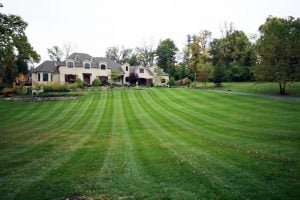Lawn Care: How to Care for Your Lawn the RIGHT Way
Lawn care goes beyond just cutting your grass when it gets too long. Mow smarter this year with our expert tips on maintaining a healthy lawn, year round! Our lawn care manager Robert Boehm shares information on general mowing guidelines as well as what height your mower should be set to, depending on what type of grass you have in your own yard. Pick up his expert lawn care tips below!
Mowing
In order to maintain a quality lawn, the turf must be mowed correctly. Mowing is considered a stress to the grass plant. It removes leaves that generate energy for plant growth and development. To survive, the grass plant uses reserve carbohydrates to regrow leaves. In order to minimize plant stress from mowing, mow tall and frequently so that no more than ⅓ of the leaf blade is removed with a single mowing. Mow at the high end of the recommended range of mowing heights for the different turfgrasses will produce the best lawns.
General Lawn Mowing Tips
- Make sure your lawn mower’s blades are sharpened.
- Avoid mowing wet turf.
- Alternate the mowing pattern to avoid soil compaction and wear.
- Most mowers should be set at the highest setting.
- Mow often enough not to remove more than ⅓ of the grass blade at any mowing.
The Proper Mowing Height
The following mowing heights pertain to the types of grass in our area.
- Tall Fescue 3.0”-4.0”
- Fine Fescue 2.5”-3.0”
- Kentucky Bluegrass 2.5”-3.0”
- Perennial Ryegrass 2.5”-3.0”
- Zoysiagrass 2.0”-3.0”
- Bermudagrass 2.0”-3.0”
 When a lawn is mowed incorrectly, the turf can become thin and allow weeds to invade. Turf mowed too short will have a poorly developed root system and have less tolerance to disease, insects and drought.
When a lawn is mowed incorrectly, the turf can become thin and allow weeds to invade. Turf mowed too short will have a poorly developed root system and have less tolerance to disease, insects and drought.
This year, our lawn care teams are using a new organic material called C20 that will build the soil. It will feed the soil microbes already in the soil that feed the plants. It will also help your soil become more porous and less compacted without aeration. As a result C20 builds the soil and will allow the nutrients already in the soil to become more readily available to the turf.
Control for broadleaf weeds will be applied later this season, because the soil temperature is still too low for weeds to come up.
Interested in learning more? Visit our lawn mowing and trimming page to learn more about proper landscaping maintenance. You can also visit our St. Louis-area lawn care services map to see if we’re mowing grass in your neighborhood.
Article written by: Robert Boehm, Lawn Care Manager at Quiet Village Landscaping.
